
By 2019 food supply chains had become the largest agri-food (to 3.5 Gt CO 2 eq. yr −1), becoming larger than emissions from They also more than doubled in non-Annex I parties Largest GHG component of agri-food system emissions in Annex I parties (2.2 Gt CO 2 eq. yr −1). Post-production processes had overtaken farm gate processes to become the In fact, our data show that by 2019, pre- and Post-production processes along the agri-food system, at global, regionalĪnd national scales. Highlighted by our analysis is the increasingly important role ofįood-related emissions generated outside of agricultural land, in pre- and One key trend over the 30-year period since 1990 Post-production processes were also significant emitters of methane (49 Mt CH 4 yr −1), mostly generated from the decay of solid food waste in Conversely, farm gateĪctivities were by far the major emitter of methane (140 Mt CH 4 yr −1) and of nitrous oxide (7.8 Mt N 2O yr −1). Pre- and post-production processes emitted the most CO 2 (3.9 Gt CO 2 yr −1), preceding land use change (3.3 Gt CO 2 yr −1)Īnd farm gate (1.2 Gt CO 2 yr −1) emissions. In 2019, in terms of individual greenhouse gases (GHGs),

Conversely, the FAOSTAT data show that since 1990 land useĮmissions decreased by 25 %, while emissions within the farm gate Largely driven by a doubling of emissions from pre- and post-production Period 1990–2019, agri-food system emissions increased in total by 17 %, Livestock production processes including on-farm energy use – were 7.2 Gt CO 2 eq. yr −1 emissions from land use change, due to deforestationĪnd peatland degradation, were 3.5 Gt CO 2 eq. yr −1 and emissionsįrom pre- and post-production processes – manufacturing of fertilizers,įood processing, packaging, transport, retail, household consumption andįood waste disposal – were 5.8 Gt CO 2 eq. yr −1. System total, global emissions within the farm gate – from crop and

(range: 19 %–43 %) of total anthropogenic emissions. We find that inĢ019, global agri-food system emissions were 16.5 (95 % CI range: 11–22)īillion metric tonnes (Gt CO 2 eq. yr −1), corresponding to 31 %

We present results from the FAOSTAT emissions shares database, covering emissionsįrom agri-food systems and their shares to total anthropogenic emissions forġ96 countries and 40 territories for the period 1990–2019.


 0 kommentar(er)
0 kommentar(er)
